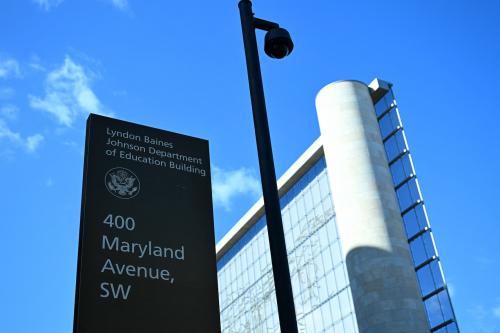What can we expect from the new regime of split party control on Capitol Hill? Some believe that divided government and a weak economy will force the president to the middle, encouraging legislative compromise on important matters of budgets, taxes, and trade. Call this the “cooler heads will prevail” model. My perspective—drawing from my research on legislative stalemate—points instead to two years of legislative deadlock.
First, divided party control typically limits legislative accomplishments. Over the past half-century, we’ve seen higher levels of deadlock in periods of divided control. Some major issues do get addressed in periods of divided control. (Think here of the major re-write of the tax code in 1986 or landmark reform of welfare policy a decade later—both under divided government.) More often than not, however, key legislative initiatives in periods of divided control are left in limbo as the parties fail to find common ground. Sometimes, inter-branch disagreement reflects truly unbridgeable policy differences. Other times we see the branches disagree strategically; they refuse to settle for half a loaf, preferring to hold out for greater gains upon the return of unified party control. Granted, unified government is no magic bullet for ensuring a productive Congress. For all Obama and the Democrats accomplished in the current Congress, much was left on the cutting room floor (immigration reform, energy legislation, a budget agreement, spending bills, tax cuts and tax reform, and so on). Still, over the postwar period, legislative stalemate is far more likely in periods of divided government.
Second, we know from the past half-century of Congressional history that partisan polarization dampens legislative compromise. The greater the ideological polarization (and sheer partisanship) in Congress, the less gets done. It is hard to get to sixty Senate votes to overcome a filibuster if there are few moderates bridging the ideological gap between the parties. The shrunken Democratic majority has produced a more liberal Democratic Caucus in the Senate, meaning that compromise with Senate GOP is even further out of reach.
Third, we often overlook the impact of bicameral disagreements on the prospects for major policy change. Put simply, legislative agreement requires House-Senate cooperation. Sometimes bicameral disagreement is hard to reach even when a single party controls Congress. (Think here of the months of machinations over health care reform over the past two years until a final accord was in hand.) Bicameral disagreement will be even less likely on controversial matters in the coming Congress given split party control of the House and Senate.
Some agreements will undoubtedly be reached in the 112th Congress, particularly on issues for which deadlines impose action—such as extending the Bush era tax cuts and funding the federal government. But beyond those key issues, incentives for compromise will remain slight. And unlike 1996 when the approaching presidential election drew the parties to the bargaining table, presidential elections do not always encourage the parties to compromise. In 2012, a poor economy and a competitive race for the White House are more likely to divide the parties further than to encourage them to work together.
The Brookings Institution is committed to quality, independence, and impact.
We are supported by a diverse array of funders. In line with our values and policies, each Brookings publication represents the sole views of its author(s).



Commentary
What Can We Expect From Split Party Control on Capitol Hill? Legislative Gridlock
November 3, 2010